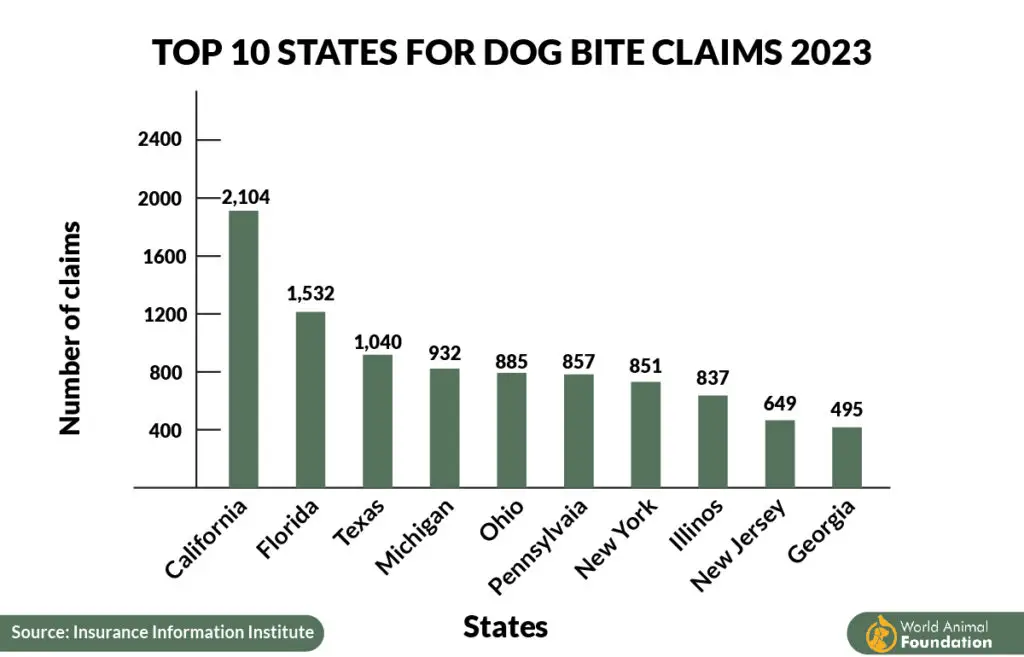Dog bites are a serious public health concern, and understanding breed-specific bite statistics can inform prevention efforts. While any dog can bite, breed variations in size, strength, and temperament contribute to bite severity and frequency. This 2024 report analyzes dog bite statistics and fatalities, exploring breed-specific data to clarify common misconceptions and promote responsible dog ownership and public safety. We’ll examine the limitations of breed-specific data while emphasizing the critical role of training, socialization, and responsible ownership in preventing dog bites regardless of breed.
Originally posted on January 30,2023, this article has been updated on August 24, 2024 to reflect the latest research and statistics. Our editorial team has ensured you’re viewing the most current data on this topic. Need help or have a question? Email us.
There’s no point in sugar-coating the topic; dog bites are a serious problem. It’s irresponsible to lay blame without having the facts. It’s just as foolish to ignore the problem and pretend that the poor dog had terrible owners. Sometimes, the beloved family pet inflicts bite injuries.
Certain breeds have risen consistently to the top for causing severe dog bite injury that seek medical attention. Breed-specific legislation has been proven that it doesn’t provide the right solution and might even create a false sense of security.
Key Stats at a Glance
- Dogs are the third deadliest creature on Earth.
- Dogs bite more than 4.5 million people annually.
- A large percentage of dog bite victims are children.
- There were 58 recorded dog bite fatalities.
- Pitbulls are responsible for 66.9% of deaths.
- California leads in dog bite claims across the US.
- Annually, tens of millions of dog bites occur worldwide.
Dog Bite Statistics
- The third deadliest creature on Earth is a dog. Part of that is the sheer number of dogs in the world. Statistics show that there are between 700 million to 1 billion dogs (pet and unowned). In underdeveloped nations, 30,000 people die yearly, and at least 59,000 people die from rabies, which is mostly transmitted by dogs.
- Dog attack stats by the American Veterinary Medical Association in the US reveal that dogs bite more than 4.5 million people annually. The vast majority of bites are underreported, but over 800,000 people bitten by dogs require medical attention. According to 2019 population figures, 1 out of 73 are victims of dog bites.
- Among 4.5 million bite victims, a large percentage of them are children. Hospital Emergency Departments treat 885,000 patients who seek medical care from bites; 370,000 of those need emergency attention, and 16 deaths occur. Children are more vulnerable and receive 70% of all bite-related deaths.
- In 2023, there were 58 recorded fatalities resulting from dog bites. Of these recorded dog bite deaths, 64% had a photo that helped identify the dog’s breed. But in 7 cases (12%), there was no information about the breed.
- According to Colorado Injury Law, between 2010 and October 2023, there were 478 deadly dog bites. Of these, 196 were from pit bulls, and another 49 involved pit bull mixes.
- According to CDC Wonder UCD data from 2005 – 2021, canines caused 662 deaths.
- In 2021, there were 81 deadly dog attacks, the highest number ever reported by CDC data. This represents a 69% rise from 2019 and a 131% increase from 2018.
- From 2005-2019, dogs killed 521 Americans, and in 2019, there were 48 dog bite-related fatality incidents.
- In 2022, dogs attacked nearly 5,300 Postal employees.Letter carriers receive training to prevent dog bite attacks but still become bite victims that require emergency care treatment. In 2020, nearly 6,000 postal worker and mail carriers were victimized compared to 5803 in 2019.
- Police dogs were responsible for 243 bites in Indianapolis from 2017-2019. The IndyStar investigated IMPD dog bites and found that many of the bite recipients were unarmed or not in breach of any high crime activity. Out of 243 victims, more than half were black, and 28% of the population.
Dog Bite Statistics By Breed
- Pitbulls are responsible for 66.9% (380) of these deaths. Breed specific legislation is a turbulent topic. Each side of the debate brings valuable content to try and help resolve the ongoing issue. What remains a fact is that the Pitty keeps making the list of dogs responsible for fatal dog bite incidents.
- Pit bulls (346) and rottweilers (51) were involved in 76% (397) of total fatal dog bites. The other fatal dog attacks involved 35 different dog breeds. German shepherds (with 238 PSI bite force) were responsible for 4.2% (24) of the attacks.
- As per Colorado Injury Law, although Pitbulls and Rottweilers make up only 6% of dogs in the US, they’re responsible for 77% of all dog bites. Pitbulls and Rottweilers may seem to be on trial, but the figures don’t lie.
- 77% of fatal bites come from Pittys and Rotties
- Pittys will bite 2.5 times more likely in multiple anatomical locations (hands and feet)
- Pitbull attacks on strangers are 31% more likely
- Pittys can attack 48% more likely without cause
- Pitty victims are more likely to die and have increased serious injuries and hospital costs than other breeds.
Further, dog bites are preventable, according to many sources like the Centers for Disease Control & Prevention (CDC).
- Among 81 dog bite-related fatalities in 2021, 20 were caused by Pit Bulls, according to Dogbite. Many Pitty rescue missions believe in saving pittys. However, Pittys are perceived as one of the aggressive dog breeds and are on the list for being responsible for the most fatal dog attacks. Pit bulls only represent 7% of the dog population. Pit bull defenders blame the dog owners and argue that dog bite statistics only tell half the story.
- Chained dogs bite 2.8 times more than unchained dogs. Since 2003, chained dogs have accounted for the killing of more than 450 Americans. Children are especially vulnerable to dog attacks. PETA outlines the events for many recorded chained dog attacks
Dog Bite Force Chart
PitBull Attack Statistics
- Colorado Injury Law states that among the fatal human attacks and bites that happened in the time period 2010 – 2023, pit bulls are responsible for 196, and another 49 were pit bull mixes, which account for 60%.
- The tendency of Pitbulls to attack a stranger is 31% higher than any other dog breed. Studies on cases of aggression prove again that bull terriers consistently act aggressively toward strangers and have a recurrence of 31%. However, pitty advocates want to prove the general public wrong and produce heartwarming versions of how lovable these dogs can be.
- Pit bull attacks show higher morbidity, hospital charges, and mortality risk than others. Maiming and human death from dog bites are rare but preventable tragedies.
- In 2018, Pit Bulls were responsible for 26 deaths. Americans need to decide how to handle the pit bull problem. Anyone with compassion for animals might easily fly to the defense of these dogs (the writer), but when pit bulls account for major dog bite victims, that number speaks loudly. Victims deserve a voice in this debate too.
Dog Attack Fatalities Statistics
- These are the top five US States for fatal dog bite statistics.
- California = 63
- Texas 54
- Florida = 47
- Georgia = 30
- North Carolina = 25
- Animal bites constitute 1% of U.S. emergency department visits, varying in severity. Even small bites can get infected. Dog and cat bites are the most common, making up more than 95% of bite injuries treated in emergency room visits.
- In 2022, 18,917 people underwent reconstructive surgery after serious dog bite injuries.
- The most common areas affected by bites are the cheek, lips, ear, and nose. Other common injuries also include punctures and arm and hand injuries.
- Dog bites make up 40% of all injuries in kids and 3% to 4% of visits to the children’s emergency department. Out of all dog bite cases in kids and adults, 81% don’t need medical care. Still, this means about 855,000 cases each year do need treatment.
- 99% of Rabies cases occur due to dogs. Rabies is a preventable but incurable disease that affects every continent except Antarctica. The rabies vaccine invented by Louis Pasteur has saved millions of lives. However, according to the CDC, rabies is still a problem in Asia and Africa, where 95% of rabies deaths occur. Most dog bite fatality victims are children. The post-bite vaccine prevents millions of deaths.
- In the US, 1-3 cases of human Rabies are reported annually. Due to strict regulations and preventive measures, “the U.S. has been free of dog rabies since 2007.” It’s definitely a little sigh of relief after learning all the shocking details of dog bites.
- In the US, stray dogs cause 15.55% of reported dog bites. Just 0.97% of stray dog bites lead to severe injury, while 1.91% of bites from non-stray dogs cause serious injury.
- 70% of US dog bites happen from unneutered (male) dogs. Unneutered dogs are 2.6 times more likely to bite people and other dogs. That means 70% to 76% of biting dogs are male.
- Approximately 78% of breed-specific dogs are kept for safety, status, brawling, and breeding. Breed-specific bans exist in America. Many states are working to remove these unfair restrictions on responsible dog owner and don’t protect the public from irresponsible owners with large dogs.As many as 78% of people with regulated dogs don’t bring them into the family. Instead, these dogs are mistreated as chattel, neglected, abused, and involved in fatal dog attacks. For many of these owners, it’s about supporting the outlaw image. They also have no qualms about chaining these dogs to develop aggression. Statistics from NCRC suggest that 70.4% of dog bite deaths were not family dogs.
- The likelihood of succumbing to a dog bite is one in 53,843.
Dog Bite Fatalities By Gender and Age
Year 2021
- Of the 81 human fatalities due to dog bites that happened in 2021, 24 were between the ages of 1-24.
- Sixteen victims of dog bites were between the ages of 25-44 years.
- Between the ages of 45-64 years, there were 17 people.
- The demographic group aged 65 and above accounted for 24 fatalities.
- From 2018 to 2021, deaths more than doubled for both males (from 15 to 37) and females (from 20 to 44).
- Of 581 fatalities between 2005 – 2020, 148% (186) were of age 0 – 24 years.
Dog Bite Claims Statistics
- In 2022, the number of dog bite claims across the country went down to 17,597 from 17,989 in 2021, showing a decrease of 2.2 percent. Insurance companies play an integral role when a dog bite occurs. The number of dog bite claims in the U.S. increased to 19,062 in 2023.
- In 2022, the number of dog attack claims in the US decreased slightly, but the total cost of these claims increased significantly by 28%, reaching $1.13 billion. The average cost per claim also rose by 32% to $64,555. The total cost of dog attack claims in the U.S. decreased to $1.12 billion in 2023.
- According to data by Triple-I, in 2022, home-owner insurance companies paid $1,136 million in dog-related injury claims, including severe dog bites. The average cost per dog bite claim in the U.S. in 2023 was $58,545.
- According to the Insurance Information Institute, in 2022, there were 1,954 claims in California alone. In 2023, California had 2,104 dog bite claims. California maintains its lead in dog bite claims across the US, recording 1,954 claims in 2022 (down from 2,026 in 2021), followed by Florida with 1,331 claims. Notably, California also tops the list for the highest average dog bite claim cost at $78,818, followed closely by Florida at $78,203. In 2023, Florida had 1,532 dog bite claims.The state of California also had the highest fatality rate in 2019, with 9 deaths.
Global Dog Bite Statistics
- Globally, tens of millions of dog bites occur annually. Universal numbers to calculate global dog bite numbers are challenging to obtain. In impoverished countries, such injuries don’t receive any dog bite liability claims. Most don’t receive medical treatment. Dog bites are a socio-economic problem and account for 76-94% of animal bites.
- There are approximately 1-2 deaths in Canada due to fatal attacks by dogs yearly. Data published by the Canadian Veterinary Journal, following dog bite stats from 1990 to 2007, revealed 28 deaths from dog bite injuries. The report didn’t list any particular breed responsible. A set of 2010 numbers concluded a decline of 28.2% over 2005, and the number of pit bulls fell by 92% since 2002 ( Toronto banned them in 2005).
- South Australia reported 500 dog bite-related hospitalization admissions in 2021-22. Children under 10 years old have the highest hospital admission rate due to dog bites—4.3 admissions per 1,000 children. This rate is significantly higher compared to other age groups, showing that children are more at risk of serious dog-related injuries.
- According to Australian dog stats, almost 13,000 people need medical care after dog bites annually. Stats found children under five have a high risk and suffer from injuries to their faces and necks. The NSW government banned these fighting breeds:
- American Pit Bull Terrier
- Dogo Argentino
- Fila Brasileiro
- Japanese Tosa
In 2020, canine bite statistics suggested that 75% of attacks come from other breeds.
- Australia records 100,000 annual dog bites, leading to 2061 hospitalizations for treatment each year on average.
- The NHS reported 9,277 hospital admissions for dog bites in 2022-23 in the UK, a 47% increase from 2012-13’s 6,317. In 2022-2023, people between the ages of 0-4 years became the most common victims of dog bites in England.
FAQs
What Percent of Dog Attacks Are Pit Bulls?
Pit bull-type dogs are responsible for 67% of deaths, and their overall population is only 6.5%. Pit Bull is perceived to be the most dangerous dog breed when it comes to fatal dog attack statistics by breed. However, dog bite prevention comes down to responsible dog breed ownership..
How Many People Are Killed by Dogs Each Year?
In the US, 83 to 88 million dogs are owned as pets. In the United States, dog attacks lead to the deaths of about 30 to 50 people each year, and the number of fatalities from these attacks seems to be on the rise.
What Dog Breed Bites the Most?
Pit bulls cause more dog bite injuries and hurt more people than any other dog, with labrador retrievers coming in second place. Many other dogs are considered dangerous breed dogs, like Doberman pinscher dogs or rottweilers, which have an extremely brutal bite force at about 328 PSI, and boxers, which have 230 PSI. But the last death involving a boxer dog happened in 2013.
How To Handle an Aggressive Dog?
Aggressive behavior in dogs sometimes needs professional intervention and behavior modification. Working with any dog takes time and energy.
Final Thought
Dog bite injuries are a grave problem. Dog bites can seriously hurt people, and dog owners might have to pay a lot of money to those who get hurt. Usually, it’s the insurance companies that cover these costs, and the settlement amounts can be pretty big. Additionally, owners might face criminal charges if their dogs cause harm.
Not all dog bites are predictable, though; with proper training and education, most fatal dog attacks are preventable. Dog bite injuries and dog bite victims are serious.
Owning any kind of pet takes a considerable commitment. Dogs are not disposable. They rely on us to teach them acceptable dog behavior. If you don’t have the time, try fostering or volunteering.
Dog bite statistics, while helpful for understanding trends, shouldn’t be used to stereotype breeds. Focusing on breed overlooks individual dog behavior, owner responsibility, and situational factors contributing to attacks. Prevention through responsible ownership, including training, socialization, and secure containment, is crucial. Accurately collecting bite data, including breed identification challenges, remains an obstacle to forming effective preventative strategies. Addressing the root causes of aggression, rather than breed alone, offers a more constructive approach to public safety.













